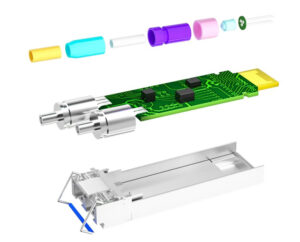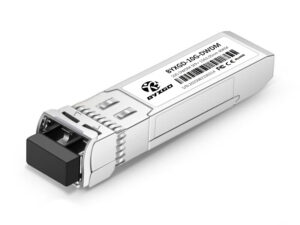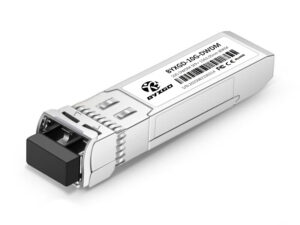Have you ever faced the challenge of optimizing your fiber infrastructure while increasing the data rates over distance? Just imagine the possibilities of gaining network capacity without additional fiber or even interrupting your operation! The answer to the challenge of increasing transmission capacity while using fiber efficiently is through the deployment of a 10G DWDM SFP+ module.
In this guide, we will highlight some of the interesting considerations behind 10G DWDM SFP+ technology, providing an overview of its specifications, how to select it, and its applications. You should therefore be able to utilize this information to move your network forward with cost-effective, high-performance DWDM for long-haul and dense networking.

10G DWDM SFP+: Why It’s the Best Choice for Long-Distance and High-Capacity Networks
10G DWDM SFP+ modules allow network operators to maximize their fiber capacity by using Dense Wavelength Division Multiplexing (DWDM) technology to transmit multiple 10 Gigabit channels over a single fiber. Each of the channels operates at a specific wavelength in tightly packed spectral grids, allowing dozens of signals to travel along the same fiber without interference.
Compared to Coarse Wavelength Division Multiplexing (CWDM), DWDM offers higher channel density and longer reach. CWDM channels have wider channel spacing, which limits the number of channels and distance, while the spacing with 10G DWDM SFP+ modules can be close—as low as 50GHz—allowing up to 80 channels over a single fiber. This allows for greater throughput and efficiency in the network.
Specific Benefits of 10G DWDM SFP+ Modules
- High Channel Density: DWDM allows for many 10G signals to be packed into the same fiber strand, allowing for increased capacity without upgrading the infrastructure.
- Extended Reach: 10G DWDM SFP+ provides greater optical budgets and dispersion management, allowing for distances well beyond what can be achieved with CWDM methods, enabling either metropolitan, long-haul, or carrier-type networks.
- Cost Savings on Leased Fiber: Maximizing fiber use allows operators to spend less on leasing additional fiber infrastructure, which for many is a significant cost component of running a network.
To understand why this matters, think about fiber as a highway. CWDM is a multi-lane highway with wider lanes but fewer total lanes. 10G DWDM SFP+ is a dense, finely divided highway. While they are ‘packed’, both types of ‘highways’ allow for more traffic, without the highway getting physically wider.
Network architects have chosen to use 10G DWDM SFP+ modules not once, but at scale across networks, to take advantage of unique 10G DWDM-specific benefits (in addition to general DWDM benefits). Everyone would like the ability to multiply their data capacity over current fibers—this is a core foundation for many service providers, businesses, and data centers supporting future-proof scalable long-distance networks.
10G DWDM SFP+ Technology Deep Dive and Selection Decision Making
The Dense Wavelength Division Multiplexing (DWDM) technology allows multiple optical signals to share a single fiber by assigning a unique wavelength or channel to each signal. Within the DWDM spectral grid, channels are mapped at very narrow spacings (typically 50 GHz or 100 GHz apart) so up to 80 channels—or even more—can occupy a fiber pair.
What are DWDM spectral grids and channels?
The optical spectrum is divided into fixed spectral grids, and the wavelength for each channel is defined on the grid as fixed. The very narrow spacing increases the fiber capacity but is only possible with high-performance lasers and fiber filters that mitigate crosstalk.
| Channel Spacing | Number of Channels per C-Band | Typical Wavelength Range (nm) | Use Case |
| 100 GHz | ~40 | 1530 – 1565 | Medium capacity, lower cost |
| 50 GHz | ~80 | 1529 – 1565 | High-capacity, long-haul |
A smaller channel spacing will add complexity, but it provides better spectral efficiency, which is critical for DWDM SFP+ modules that hope to deploy a high density of wavelengths.
Dynamically Tunable SFP+ Modules: Channel Assignment
Dynamic, tunable SFP+ modules provide a unique benefit: they allow an operator to dynamically select any wavelength channel within the spectral grid without changing hardware. This greatly aids inventory management and allows better planning with dense networks.
Tunable modules will modify the laser’s wavelength mechanically or electromechanically to adjust to real-time network requirements or channel assignments.
10G DWDM Selection Decision Tree
When choosing 10G DWDM SFP+ modules, consider the following parameters:
Transmission distance:
- Short reach (<50 km): Standard, fixed-wavelength SFP+ works.
- Long reach (>50 km): Favor tunable or extended-range modules.
Channel count:
- Few (<40): Use fixed-wavelength modules for lower cost.
- Many (>40): Opt for tunable SFP+ for flexibility and reduced inventory.
Budget:
- Limited budget: Fixed is best with planned channel allocation.
- Flexible budget: Tunable is ideal for dynamic networks.
Compatibility Note: Compatibility with DWDM MUX/DEMUX is critical. If the wavelength channel of the SFP+ module does not align with the MUX/DEMUX grid, the signal will degrade. Always research switch compatibility with vendors like Cisco, Huawei, Juniper to avoid integration issues.
10G DWDM SFP+ Product Lineup: Find the Best Solutions for Your Network

BYXGD-10GE-DWDM-SFP+-1563.05nm-40KM: The 10G DWDM SFP+ Module operates at a wavelength of 1563.05nm, over a maximum distance of 40km. The module is designed to be used with single-mode fiber. The module has an EML laser, with -1 to +3 dBm optical output. The receiver is a PIN receiver, with a sensitivity of ≤ -16 dBm. The module has a 10 dB extinction ratio, supports C-Band 100G networks, and has an LC connector interface.

BYXGD-10GE-DWDM-SFP+-1563.05nm-80KM: The 10G DWDM SFP+ module has a transmission wavelength of 1563.05nm over a distance of 80km using single-mode fiber. This module uses an EML laser with an output power ranging from 0 to +4 dBm to transmit, and an APD receiver with a sensitivity of ≤ -24 dBm. This module can also achieve a 10 dB extinction ratio and an LC interface, ideal for C-Band 100G network applications.
Fixed-Wavelength vs Tunable 10G DWDM SFP+ Modules
| Feature | Fixed-Wavelength DWDM SFP+ | Tunable DWDM SFP+ |
| Channel Flexibility | Limited to one wavelength | Adjustable across grid |
| Inventory Management | Requires multiple SKUs | Single SKU covers all channels |
| Deployment Speed | Slower if channels change | Faster due to reconfigurability |
| Initial Cost | Lower | Higher |
| Network Complexity | Higher due to planning | Lower due to adaptability |
| Optical Performance | Stable, proven | Also stable, with tuning |
Tunable 10G DWDM SFP+ modules are particularly beneficial in networks where the channel plan is dynamic or if access to a smaller inventory is desired, as a tuned module can offer the flexibility to adapt to channel modifications to support quick changes. For fixed-wavelength modules, they fit into more static deployments or are perhaps budget-friendly on the low end.
Having a balanced view of spectral grids, tunable, compatibility, etc., ultimately helps in making an educated decision when selecting 10G DWDM SFP+ modules for reach optimization, network capacity, and budget management.
OEM 10G DWDM SFP+ Modules vs Third-Party 10G DWDM SFP+ Modules
Selecting the correct supplier for a 10G DWDM SFP+ module is ideal for reliability and managing cost factors. OEM modules are modules that have been developed and tested by original equipment manufacturers to guarantee seamless use to maintain performance reliability as well. Third-party modules, on the other hand, usually save customers money, but as with most third-party products, lower quality may be a concern.
Brand Comparison and Testing Information
When comparing brands, laboratory testing confirms what most manufacturers value: OEM 10G DWDM SFP+ modules have consistently demonstrated stable optical power levels, low error rates in the lab and with on-field operations, while maintaining full compatibility with the chassis in which they operate.
When using a third-party module, however, the same assurance cannot be guaranteed. Third-party modules can perform at varying levels during testing in comparison. Although the best third-party brands perform similarly to OEM brands, the ability for an OEM to eliminate signal paths from a multi-vendor module will be a deciding factor, and less reputable third-party brands may either degrade signals or completely fail to interoperate with OEM products.
Visual Comparison: Key Factors
| Aspect | OEM Modules | Third-Party Modules |
| Performance | Consistent, tested | Variable; high-end comparable |
| Price | Premium | 30%-50% lower |
| Compatibility | Guaranteed with gear | May require validation |
| Warranty | Extensive, vendor | Often limited or shorter |
| User Feedback | Positive, reliable | Mixed; depends on brand |
Verified User Feedback
Network administrators generally have few concerns regarding OEM modules and their plug-and-play capabilities. Users who choose reliable third-party modules emphasize the great cost savings without a decrease in performance. Some users reported issues with third-party aftermarket modules, including not being detected and an increased error rate.
Analysis in a lab confirmed that OEM modules outperform third-party modules in terms of power budget stability but tested a few third-party modules at the edge that performed comparably to OEM modules.
Whether to choose OEM versus third-party options for purchasing 10G DWDM SFP+ modules is an exercise in balancing financial constraints with risk tolerance. For mission-critical applications, there is really no argument on whether spending the extra money on OEM modules is justified. For more flexible installation environments, continually adjusting and validating third-party modules is a great value without loss of performance or risk of a catastrophic occurrence.
This analysis should encourage the professional network administrator to make purchasing decisions with confidence and a cost-benefit-reasonable option that aligns with technical performance requirements and their organization’s budget.
Real-World Example and Future Status of 10G DWDM SFP+ Capability
The CEO and engineers from a national telecommunications provider provided a team to research and support the rapid growth of data traffic over their long-haul network, while also being constrained by limited fiber infrastructure to their maximum capacity as the network approached existing fiber resources to capacity levels. Expanding that fiber and the scale of what was once a customer’s line of service can be costly in terms of fiber installation outside of the provider’s fiber footprint to maximize customer demand and profitability, all while controlling costs to the client.
Project Challenges
- Existing fiber resources nearing full utilization.
- Heavy reliance on expensive fiber lease contracts.
- Need for scalable solutions that can be supported with the legacy capacity of base stations.
Solution and Deployment
To multiplex multiple 10G channels over the same fiber strands, the 10G DWDM SFP+ modules with DWDM MUX/DEMUX can be combined at the installation site. Fixed and tunable DWDM transceivers will be capable of facilitating and managing channel assignments requiring minimal inventory, thus facilitating multiple cable assignments.
The implementation of the 10G modules and hardware was done in conjunction with the advanced capabilities of the DWDM hardware at the site. By maintaining existing and prior investments, this was a seamless plug-and-play implementation with existing customers.
Measurable Benefits and ROI
- Threefold increase in data throughput without deploying additional fiber.
- Reductions in leasing fiber expense costs of 40% through efficient use of the fiber.
- Faster rollout timelines due to the plug-and-play nature of the module and flexible tuning.
DWDM Trends and Future Coexistence
Representatives from some public fixtures predict that 10G DWDM will become ubiquitous, thus allowing for further expansion and utilization for subsequent high-speed standards such as 25G and 100G Ethernet. Tunable optics will be the beginning of a continuing trend of fluid networks.
This trend in networking will ensure that 10G DWDM will remain a valuable technology for both metro and carrier environments scaling while managing costs as networks scale. Hybrid networks can be used consisting of 10G DWDM paired in the same network with higher-rate technology to further optimize traffic flows and increase the value of the investment.
The trend between the DWDM with the hybrid networks emphasizes that the DWDM module can serve as a backbone of a rapidly evolving 10G, 25G, and 100G networks. This case study and outlook of the future show that 10G DWDM SFP+ modules will enhance the capability of service providers to meet client demand for rapid network growth while also meeting sales requirements when preparing to utilize their next-generation optical networks for customers.
FAQ's
DWDM operates on a precise grid of channels, with each channel spaced tightly based on a specified wavelength. Successful management of the DWDM channels involves necessary planning, as you will want to ensure that the 10G signal is appropriately placed at its own unique frequency channel on the grid. Using a MUX/DEMUX (Multiplexer / Demultiplexer), you can perfectly arrange just the right amount of wavelengths to ensure that signals do not interfere with each other.
It is important to be aware of the quality of fiber, and how that will affect your 10G DWDM signal strength and distance. As a general rule, optical power budgets are explained in dBm, and are an important specification to use when validating modules or distances for your deployment to account for fiber loss. You will also want to make sure that the optical power levels always fit within the specifications so that performance will not be affected, which could result in link errors.
For a 10G DWDM SFP+ module, it should always be a single-mode fiber with a very low signal loss. It is important to ensure that you use the right fiber type, the connectors are clean, and the fiber bends are kept to a minimum so that there is no degradation of the signal. The cable polarity, as well as labeling, is also important when deploying DWDM channels.
Vendor and firmware compatibility make this a dependent question. When using generic SFP+ modules, you also must be cognizant of the major brands (e.g., Cisco, Juniper, and Huawei) who support 10G DWDM SFP+ modules, as not all modules or combinations will be recognized. As a general rule, make sure to validate modules against the vendor’s compatibility document.
Contact Us For The Best Solution
10G DWDM SFP+ modules are at the IPL, a superb choice for any situation where you are looking to scale the high-capacity, long-distance coverage of any kind, while solving for the most efficient use of the fiber you have available. The many combinations to utilize the multi-channel capability of 10G DWDM SFP+ modules put you in a better cost structure overall, while giving flexibility to the network’s operation.
Review a full selection of many combinations of 10G DWDM SFP+ solutions that you could find to fit your application! Work with network experts or SFP+ module vendors to ensure you have the right solution without the aggravation typically associated with the planning and installation of the modules, in order to have a completed and seamlessly integrated successful deployment that always drives toward and supports future network performance growth.
